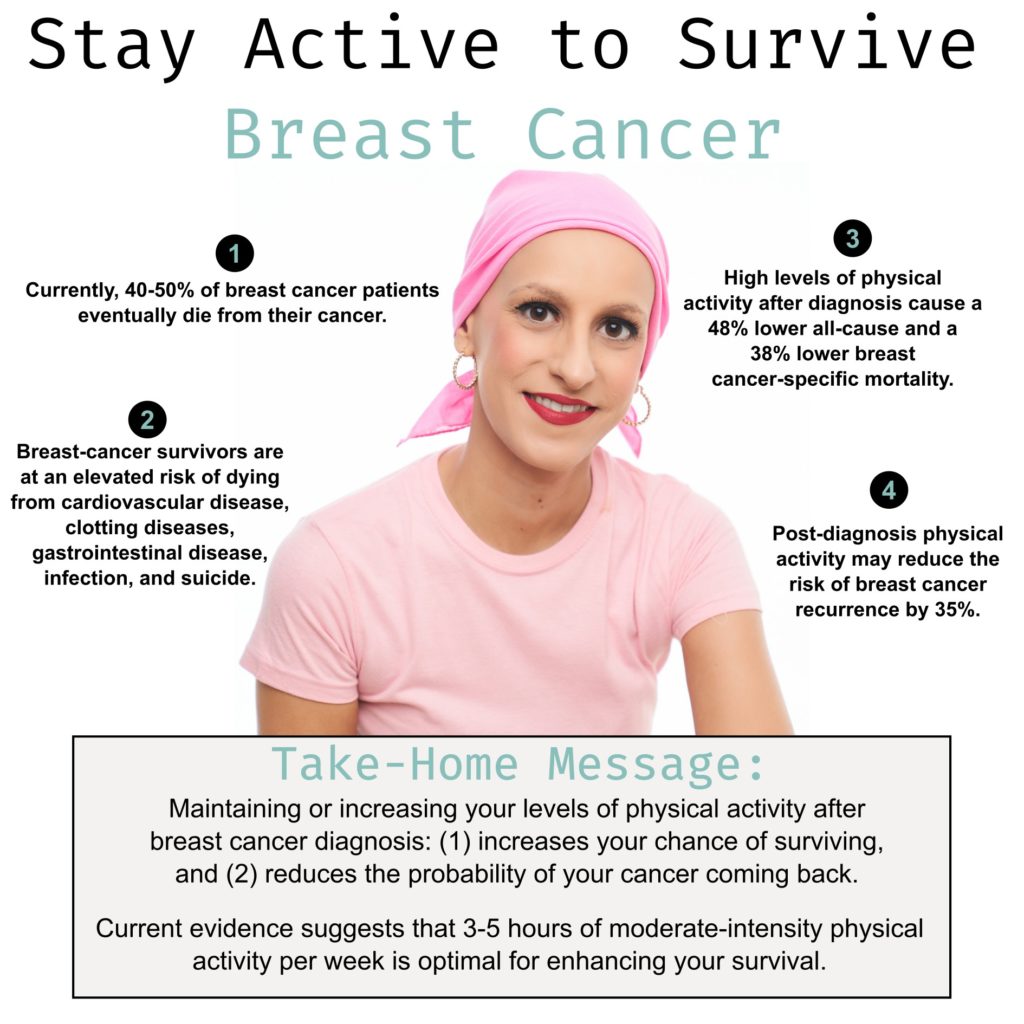Stay Active to Survive Breast Cancer

“Action is the foundational key to all success.”
– Pablo Picasso
1. Executive Summary
By engaging in moderate physical activity after being diagnosed with breast cancer, you significantly reduce your risk of death and cancer recurrence.
In stark contrast, if you decrease your levels of physical activity after your diagnosis, you greatly increase your chance of dying from your disease.
2. Introduction
As a cancer researcher who’s worked closely with cancer patients and their families, I know first-hand the devastating impact of being diagnosed with cancer.
Facing a cancer diagnosis is an intensely challenging experience, one that brings with it many fears and uncertainties. Will the cancer come back? What’s my life expectancy? How can I improve my odds?
If you’ve found yourself asking these questions, you’re far from alone.
In this article, I argue that staying physically active after your breast cancer diagnosis doesn’t just reduce your chance of dying, but it also plays a significant role in preventing your cancer from returning.
3. Breast Cancer Increases Mortality
Breast cancer is the most common cancer in women, and the most common cancer overall (1).
Fortunately, the 5- and 10-year relative breast cancer survival rates are now 91% and 85%, respectively, largely due to early diagnosis. An early diagnosis means the cancer can be removed before it has had time to spread to other parts of the body, such as the kidney or brain (2).
Nevertheless, even with an early diagnosis, the greatest risk to breast cancer patients remains the cancer itself, with 40-50% of patients eventually dying from their cancer (3).
Moreover, the negative long-term consequences of surviving cancer have become clear. For example, it is now known that breast-cancer survivors are at a significantly elevated risk of dying from cardiovascular disease (4-6). Furthermore, breast cancer survivors also have a higher risk of dying from clotting diseases, gastrointestinal disease, infection, and suicide (3).
4. Why do breast cancer survivors have an elevated risk of death?
There are several reasons why breast cancer survivors are at an elevated risk of premature death.
First, many risk factors for breast cancer and other diseases overlap, such as diet, smoking, and obesity (7, 8). Thus, people who are more likely to get breast cancer are also more likely to experience additional serious health conditions.
Second, patients who are treated with chemo- and radiation therapy, are more likely to develop cardiovascular and clotting disease (3, 8).
Third, cancer diagnosis, surgery, and treatment can increase the risk of an early death by significantly disrupting the healthy lifestyle of cancer patients (3). For example, cancer and therapy related symptoms such as fatigue and nausea, can lead to the loss of muscle mass and increased adiposity, thereby elevating the risk of overall mortality (3).
Finally, other cancer-related outcomes, such as body alterations resulting from surgery, chronic pain, and cognitive decline, can increase feelings of social isolation, anxiety, and depression, with knock-on reductions on overall health and long-term survival.
5. Evidence that Physical Activity after Diagnosis keeps Breast Cancer Patients Alive
In this article I’m focusing on the wonderful meta-analysis recently published in the International Journal of Cancer, authored by Margarita Cariolou and Colleagues (9).
But before we dive into the science, it’s first worth revisiting the idea and purpose of a meta-analysis so that you can better appreciate the value of the research presented.
So, what is a meta-analysis anyway?
Imagine you’re interested in a particular question, such as whether physical activity improves breast cancer patient survival. Now, instead of relying on just one study, imagine that you could combine the data from multiple independent studies to answer the research question.
This is exactly what researchers do when they perform a meta-analysis.
To begin a meta-analysis, researchers first gather all the relevant studies they can find, carefully select the ones that meet specific criteria for quality and relevance, and then extract and analyze the data from those studies. Then, by combining the results of these individual studies, they can calculate overall estimates of the treatment’s effectiveness.
The crucial advantage of the meta-analysis is that they help to overcome the limitations of individual studies, which might suffer from small sample sizes or inconsistent findings. Thus, by combining data from multiple studies, researchers increase the statistical power to get a more precise estimate of the treatment effect.
In summary, by synthesizing all the available evidence into a single study, a meta-analysis gives researchers and clinicians a more reliable understanding of the effectiveness of therapeutic interventions.
6. What the Researcher’s Found
Cariolou and Colleagues performed a meta-analysis of 20 independent studies to summarize the evidence on the relationship between engaging in physical activity after breast cancer diagnosis with (i) mortality, and (ii) tumor recurrence (9).
They examined the impact of physical activity on all-cause mortality as well as cancer-specific mortality.
All-cause mortality refers to the measurement of deaths from any cause within a specific population during a defined period. It’s a way of looking at the overall number of deaths in a particular population, regardless of the specific reasons or causes behind those deaths.
By contrast, cancer-specific mortality refers to death caused by the cancer itself.
Strikingly, the Author’s found that high levels of physical activity after diagnosis were associated with a 48% lower all-cause and a 38% lower breast cancer-specific mortality (9), providing strong evidence that high-levels of physical activity protect breast cancer patients against premature death.
Crucially, the analysis of Cariolou and Colleagues are supported by twelve previously published meta-analyses (summarized in Table One), all of which conclude that physical activity reduces the risk of overall and/or cancer-related death in breast cancer patients.
So, does physical activity after diagnosis decrease your risk of death?
Yes, it does.
| Publication | Year Published | Does Physical Activity Reduce All-Cause Mortality? | Does Physical Activity Reduce Cancer-Specific Mortality? | Optimal Weekly Volume | Optimal Training Intensity |
| Cariolou et al (9) | 2023 | Yes | Yes | 5 Hours | Moderate |
| Zagalaz-Anula et al (10) | 2022 | Not Analyzed | Yes | Not Analyzed | Not Analyzed |
| Salam et al (11) | 2022 | Yes | Yes | Not Analyzed | Both Moderate and Moderate-Vigorous |
| Friedenreich et al (12) | 2020 | Yes | Yes | 3-4 Hours | Moderate |
| Geidl et al (13) | 2020 | Yes | Not Analyzed | 5 Hours | Moderate |
| Spei et al (14) | 2019 | Yes | Yes | Not Analyzed | Both Moderate and Moderate-Vigorous |
| Lee (15) | 2019 | Yes | Yes | 5 Hours | Moderate |
| Patel et al (16) | 2019 | Yes | Yes | Not Analyzed | Not Analyzed |
| Falcetta et al (17) | 2018 | Yes | Trending Yes (not statistically significant) | Not Analyzed | Not Analyzed |
| Lahart et al (18) | 2015 | Yes | Yes | At least 2.5 hours | Not Analyzed |
| Zhong et al (19) | 2014 | Yes | Yes | 2.5 hours | Moderate |
| Schmid & Leitzmann (20) | 2014 | Yes | Yes | 2.5 Hours | Moderate |
| Ibrahim & Al-Homaidh (21) | 2011 | Yes | Yes | At Least 2 Hours | Moderate |
7. Does Physical Activity after Diagnosis Reduce the Risk of Tumor Recurrence?
One of the greatest fears of breast cancer survivors is that the tumor will come back, the phenomenon of tumor recurrence (22).
Unfortunately, the probability of recurrence for breast cancer is about 25% (23), with fewer than 5% of patients with recurrent tumours surviving more than 10 years (23). Moreover, the fear of recurrence significantly reduces the quality of life for many breast cancer survivors (22). Thus, it is of intense interest to both clinicians and patients whether physical activity reduces the risk of tumour recurrence.
While Cariolou and Colleagues found that physical activity does appear to reduce the risk of tumor recurrence, this effect did not reach statistical significance (9). However, because they only analyzed three studies that investigated tumor recurrence, we can’t draw a robust conclusion.
Luckily, two recent meta-analyses focused explicitly on the role of physical activity in reducing the risk of breast cancer recurrence (10, 24). Miyamoto and Colleagues found that post-diagnosis physical activity reduces the risk of breast cancer recurrence by 35% (24), and Zagalaz-Anula reported that postdiagnosis physical activity reduced the risk of recurrence by 16% (10).
So, does engaging in physical activity after breast cancer diagnosis decrease your risk of disease recurrence?
The evidence strongly suggests yes.
8. You Must Avoid Inactivity
Finally, do your best to avoid inactivity after your breast cancer diagnosis!
Why?
Because a meta-analysis of Dr Lee performed in 2019 showed that breast cancer patients who decreases their physical activity levels after diagnosis experience a whopping 236% increased risk of death (15)!
9. What’s the best way to stay active after a breast cancer diagnosis?
The extensive research reviewed above makes it crystal clear that maintaining physical activity is crucial for maximizing your survival.
So, what’s the best type of exercise for breast cancer patients?
Well, the current evidence suggests that 3-5 hours of moderate-intensity physical activity per week, is optimal for enhancing your survival (9).
This finding is consistent with the American College of Sports Medicine guidelines for cancer survivors (16), which states that:
“Based on the current literature, an effective exercise prescription that most consistently addresses health-related outcomes experienced due to a cancer diagnosis and cancer treatment includes moderate intensity aerobic training at least 3 times per week, for at least 30 minutes, for at least 8–12 weeks. The addition of resistance training to aerobic training, at least 2 times per week, using at least 2 sets of 8–15 repetitions at least 60% of one repetition maximum, appears to result in similar benefits.” (16)
10. But what exactly is moderate intensity exercise?
A precise definition of moderate intensity exercise is difficult to pin down, especially for cancer patients, because what you consider to be moderate intensity depends on your current level of physical fitness (25). Nevertheless, some commonly cited examples of moderate-intensity exercise include brisk walking, dancing, playing doubles tennis, raking the yard, and slow swimming (25).
However, if you are looking for more detailed information about specific types of exercise that are appropriate for cancer survivors, I highly recommend visiting the American College of Sports Medicine webpage Moving Through Cancer.
Finally, I strongly recommend that you consult with your oncologist before commencing an exercise program. Your oncologist is the best person to advise you on the safest and most effective exercise approaches that match your specific health requirements during and after therapy.
11. Take Home Message
Maintaining or increasing your levels of physical activity after your breast cancer diagnosis (1) increases your chance of surviving, and (2) reduces the probability of your cancer coming back.
In contrast, becoming less active after your diagnosis dramatically increases your chance of dying.
So, if you want to survive, stay active!

Acknowledgements
Images creates by Jose Luis Montoya Retamosa and Roberto Jimenez
12. References and Further Reading
1. F. Bray et al., Global cancer statistics 2018: GLOBOCAN estimates of incidence and mortality worldwide for 36 cancers in 185 countries. CA: a cancer journal for clinicians 68, 394 (2018).
2. A. C. Society, Cancer Facts & Figures 2023. Atlanta: American Cancer Society 2023, (2023).
3. M. Riihimäki, H. Thomsen, A. Brandt, J. Sundquist, K. Hemminki, Death causes in breast cancer patients. Ann Oncol 23, 604-610 (2012).
4. J. L. Patnaik, T. Byers, C. DiGuiseppi, D. Dabelea, T. D. Denberg, Cardiovascular disease competes with breast cancer as the leading cause of death for older females diagnosed with breast cancer: a retrospective cohort study. Breast Cancer Research 13, R64 (2011).
5. P. T. Bradshaw et al., Cardiovascular Disease Mortality Among Breast Cancer Survivors. Epidemiology 27, 6-13 (2016).
6. S. A. M. Gernaat et al., Risk of death from cardiovascular disease following breast cancer: a systematic review. Breast Cancer Res Treat 164, 537-555 (2017).
7. R. Haque et al., Comorbidities and cardiovascular disease risk in older breast cancer survivors. Am J Manag Care 20, 86-92 (2014).
8. S. P. Cherukuri et al., Breast Cancer and the Cardiovascular Disease: A Narrative Review. Cureus 14, e27917 (2022).
9. M. Cariolou et al., Postdiagnosis recreational physical activity and breast cancer prognosis: Global Cancer Update Programme (CUP Global) systematic literature review and meta-analysis. Int J Cancer 152, 600-615 (2023).
10. N. Zagalaz-Anula, M. J. Mora-Rubio, E. Obrero-Gaitán, R. Del-Pino-Casado, Recreational physical activity reduces breast cancer recurrence in female survivors of breast cancer: A meta-analysis. Eur J Oncol Nurs 59, 102162 (2022).
11. A. Salam et al., Effect of post-diagnosis exercise on depression symptoms, physical functioning and mortality in breast cancer survivors: A systematic review and meta-analysis of randomized control trials. Cancer Epidemiol 77, 102111 (2022).
12. C. M. Friedenreich, C. R. Stone, W. Y. Cheung, S. C. Hayes, Physical activity and mortality in cancer survivors: a systematic review and meta-analysis. JNCI cancer spectrum 4, pkz080 (2020).
13. W. Geidl, S. Schlesinger, E. Mino, L. Miranda, K. Pfeifer, Dose-response relationship between physical activity and mortality in adults with noncommunicable diseases: a systematic review and meta-analysis of prospective observational studies. Int J Behav Nutr Phys Act 17, 109-109 (2020).
14. M. E. Spei et al., Physical activity in breast cancer survivors: A systematic review and meta-analysis on overall and breast cancer survival. Breast 44, 144-152 (2019).
15. J. Lee, A Meta-analysis of the Association Between Physical Activity and Breast Cancer Mortality. Cancer Nurs 42, 271-285 (2019).
16. A. V. Patel et al., American College of Sports Medicine Roundtable Report on Physical Activity, Sedentary Behavior, and Cancer Prevention and Control. Med Sci Sports Exerc 51, 2391-2402 (2019).
17. F. Soares Falcetta et al., Effects of physical exercise after treatment of early breast cancer: systematic review and meta-analysis. Breast Cancer Res Treat 170, 455-476 (2018).
18. I. M. Lahart, G. S. Metsios, A. M. Nevill, A. R. Carmichael, Physical activity, risk of death and recurrence in breast cancer survivors: A systematic review and meta-analysis of epidemiological studies. Acta Oncol 54, 635-654 (2015).
19. S. Zhong et al., Association between physical activity and mortality in breast cancer: a meta-analysis of cohort studies. Eur J Epidemiol 29, 391-404 (2014).
20. D. Schmid, M. F. Leitzmann, Association between physical activity and mortality among breast cancer and colorectal cancer survivors: a systematic review and meta-analysis. Ann Oncol 25, 1293-1311 (2014).
21. E. M. Ibrahim, A. Al-Homaidh, Physical activity and survival after breast cancer diagnosis: meta-analysis of published studies. Med Oncol 28, 753-765 (2011).
22. L. Koch et al., Fear of recurrence in long-term breast cancer survivors-still an issue. Results on prevalence, determinants, and the association with quality of life and depression from the Cancer Survivorship-a multi-regional population-based study. Psycho-Oncology 23, 547-554 (2014).
23. V. Sopik, P. Sun, S. A. Narod, Predictors of time to death after distant recurrence in breast cancer patients. Breast Cancer Res Treat 173, 465-474 (2019).
24. T. Miyamoto, A. Nagao, N. Okumura, M. Hosaka, Effect of Post-diagnosis Physical Activity on Breast Cancer Recurrence: a Systematic Review and Meta-analysis. Curr Oncol Rep 24, 1645-1659 (2022).
25. B. R. MacIntosh, J. M. Murias, D. A. Keir, J. M. Weir, What Is Moderate to Vigorous Exercise Intensity? Front Physiol 12, 682233 (2021).

Ten Minutes is All You Need
Research has shown that ten minutes of moderate-to-vigorous exercise performed each day is enough to significantly reduce your risk of early death.




